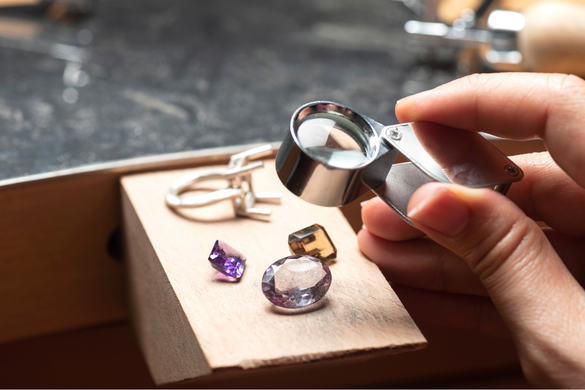Handling of Diamonds & Gems in Jewellery Manufacture

Who would benefit from the gem knowledge? Those who play active, responsible and profitable part handling gems in the jewellery manufacturing need this knowledge.
The potential for damage depends on the different characteristics of gemstones, such as mechanical resistance, chemical resistance, thermal stability, stability of colour and the way in which a stone is cut.
Damage to diamond may also occur because the wearer believes that diamonds are indestructible.
Types of Damage :
- Mechanical Damage: Breakage, cleavage, chipping, abrasion.
- Thermal Damage: Cracking, decomposing, burning
- Chemical Damage: Etching, corrosion
- Changes of appearance due to colour fading, decomposition.
Opportunities for Damage:
- Geology, tectonics, metamorphosis, weathering.
- Mining activity, handling of gems.
- Cutting, polishing, setting
- Wear & tear
- Soldering (heat, tensions)
- In-situ diamond setting in lost wax casting process.
- Acid pickling using sulphuric acid.
- Cleaning in Ultrasonic using acid, solvents, & dunking vibrations during cleaning process in ultrasonic.
- Heating the shellac during setting process with in-situ set diamond.
- Abrasion: Use of harsh abrasives & large wheels during polishing process.
- Chips: Hammering the rings during sizing, earring or other studded jobs during repair of porosity in filing & finishing.
- Burning or chipping: Re-tipping of prongs during manufacture of jewellery using laser welders. This damage can be prevented using Heat shield or borax, boric acid which is painted on Diamond.
- Pressure & percussion. Diamond is sensitive to percussion and pressure during daily wear though it has high scratch hardness. Because of knocking and rubbing with other diamonds facet edges & corners appear white after a period of wear. Sharp-edged & thin girdles on diamonds are likely to be damaged; they can chip during setting or latter in wear.
Worn edges and corners on a brilliant cut diamond with a scratch across a main facet. Diamonds are not indestructible but quite sensitive to knocks and contact with other diamonds.
Diamond particles under the metal clamp cause scratches when the stone is turned in the dop for crown facet cutting. Such scratches are visible at 10X.
Forced closing of the claws of the dop for pavilion facet cutting may cause pressure marks. Such fissures may be visible at 10X and affect the clarity grade.
A stepped chip on a diamond facet caused by laser shot. In centre of the crater a black spot of graphite is visible.
Burned surface spots of a brilliant cut diamond at 30X.
Burned surface caused by soldering repair to a ring containing 0.31 cts brilliant cut diamond.
Chip on the girdle of a brilliant cut diamond, situated in an area where girdle is thin. Thin or sharp edged girdles are potential damage zones.
References: Hänni, H.A., 2009. Durability, damage and distress. Gems & Jewellery 18/(2),3-8
Further reading: Hanni,H.A, and Bosshart,G., 1987. Damage to cut diamonds. Journal of Gemmology, 20(6), 339-43

